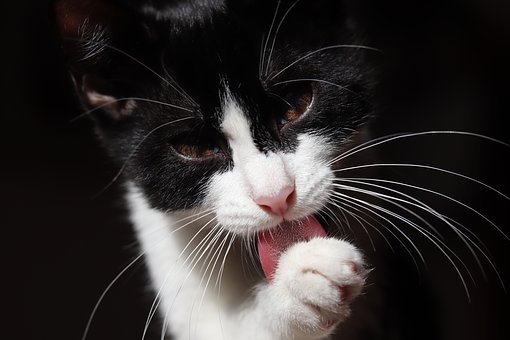 Your cat’s whiskers are highly tactile hairs. These grow in a pattern and can be found above the cat’s eyes and on its muzzle. Whisker hairs also grow elsewhere on the cat’s body, such as his ears, jaw, and forelegs.
Your cat’s whiskers are highly tactile hairs. These grow in a pattern and can be found above the cat’s eyes and on its muzzle. Whisker hairs also grow elsewhere on the cat’s body, such as his ears, jaw, and forelegs.
These sensory tools help the cat in many ways. For example, they can help him see in the dark, because they sense or contact objects nearby. They can also help the cat to steer clear of larger predators.
Do not groom, trim, or cut off those whiskers. It would be kind of like cutting off your fingers. Without these hairs, cats become very disoriented and frightened. It would be like our trying to get around without the sense of touch.
It is okay to touch your cat’s whiskers, but do not pull on them. That would hurt! Those long eyelashes and pretty whiskers are not just decorations, but are more like antennae, or fingers. They help your cat to navigate and to keep out of trouble.
If your cat gets stressed, it is possible that he will lose hair or whiskers. If you move or get a new pet, sometimes this change in the cat’s regular routine will stress him. Allergies, too, can cause cats to lose hair or whiskers.
My cat, Carlos, lost a lot of hair when he developed an allergy. First it came off his tail, then started falling off his tummy, and slowly moved up his sides, like rising water. Fortunately, I found out what he was allergic to, removed it from his diet, and the hair grew back.
moved up his sides, like rising water. Fortunately, I found out what he was allergic to, removed it from his diet, and the hair grew back.
The long whiskers on the cat’s cheek helps determine whether he can fit through a space. The whiskers grow to just the right length. The feline knows that if the whiskers will go through, the rest of him will fit as well.
Your kitty’s cheeks contain sweat glands, which allow the cat to leave his scent on things to mark his territory. Those cheeks, which are so tempting to your fingers, are a choice spot to scratch. Your cat will enjoy it if you rub his fur from his cheek whiskers back toward the tail, as well as under the jaw and along the neck. Carlos liked to be rubbed under his chin.
Some people erroneously think that balance is somehow regulated by the whiskers. This is not correct. The cat’s balance is controlled by the inner ear.
People believe that finding a cat’s whisker is good luck. I have kept my cat’s whiskers when I found them — you never know — nowadays we could use all the luck we can get. If they don’t bring good luck, they are at least a good keepsake.
 Please be aware that a cat does not shed whiskers too often. If your cat is losing whiskers frequently, contact your vet.
Please be aware that a cat does not shed whiskers too often. If your cat is losing whiskers frequently, contact your vet.
If a cat does lose his whiskers for some reason, be reassured that they grow back. It will take two to three months. When I first got my Sam Cat on Spruce Island, he had lost all his whiskers in a fire.
When he was still a kitten with his mother, he lived with the people who resided over the hill from me. One of them built a big bonfire on the beach, poured on a bit of fuel and lit it. He didn’t know that the black kitten was on the other side of the pile.
When the fire took off with a giant whoosh, the small black cat shot straight backwards. He was undamaged, but his whiskers were all burned off. He also developed a great skill of running backwards very fast when necessary. The neighbors called him “rooster” after the whiskers burned, until I brought him home and restored his dignity by naming him Sam.
At night, if your cat is outside, changes in air currents help him locate prey, even though it is dark. Cats can navigate around objects in the dark because the whiskers pick up changes in the air currents moving around objects. This information tells the cat exactly where the object is. This skill seems to be almost as good for the cat as if he were wearing a headlamp.
Cat’s whiskers do not grow longer as they age. The rigid whisker hairs usually stay at the same length for the cat’s lifetime, unless accidentally cut. When one cat whisker falls out, there will soon be another one there to replace it.
 If the cat has to close his eyes to protect them from danger, the small whiskers above the eyes — those two clumps of whiskers that grow there — will act as a second set of eyes until he can see again.
If the cat has to close his eyes to protect them from danger, the small whiskers above the eyes — those two clumps of whiskers that grow there — will act as a second set of eyes until he can see again.
Catster.com says that cat whiskers are the Swiss army knife of your cat’s sensory and communications tools. That site furnished the following list of interesting facts about those whiskers.
1. Cat whiskers are exquisitely sensitive. They are so sensitive that it is a good idea to feed the cat from a plate or a wide bowl to keep the whiskers from touching it and possibly causing discomfort. I had to find a WIDE water bowl for Carlos, as he had loooong whiskers which would not fit into a smaller water bowl.
2. Cat whiskers are not just on the nose. Besides the nose, there are whiskers above the eyes, on the chin, and on the backs of the lower front legs.
3. Whiskers allow the cat to figure out where he’ll fit. The whiskers grow as long as the cat is wide. Better not let him gain weight. Side note: I did see one remark from a reader who said she thought her cats whiskers had grown longer when the cat gained weight. Have any of you observed anything similar?
4. Whiskers help the cat locate the exact position of her prey. The whiskers on the forelegs, and also those on the chin and sides of the nose help pinpoint the exact location of the prey, even if the cat cannot see it.
5. Cat whiskers are an emotional barometer. The position reflects kitty’s mood. When the animal is relaxed and calm, the whiskers are sticking out sideways. If the whiskers are pushed forward, the cat is excited or alert. When they are flattened against his cheeks,  he is angry or scared.
he is angry or scared.
6. NEVER cut your cat’s whiskers. If you were ever blindfolded and couldn’t take off the blindfold for a few weeks, you would understand how the cat feels if his whiskers are cut.
7. Cat whiskers can change color. Yes, it can happen with aging. Carlos’s whiskers started out white, and they stayed that way. He had very handsome whiskers on his sweet face.
Now you have a bit more understanding of the cat’s very important tool, his whiskers. Please comment below if you have observed any unusual whisker-induced behavior.


What an interesting article about cats whiskers. I had no idea that they were such a necessary tool for cats to help them determine their surroundings. I also didn’t make the connection that the hairs above their eyes were whiskers too. I just thought of them as long eyebrow hairs. I will be careful to never cut their whiskers, that’s for sure!
Glad you learned a bit about cat’s whiskers. They are very important tools in the cat’s toolbox. Yes, be sure never to cut those whiskers.
Hi! Thank you very much! I’m glad I read your post just on time. My cat is also happy with you.
You have presented the idea of cats whiskers as antennae or fingers. And I really like that figure. I think your post is worth sharing. There are people out there believing they are making their cat prettier, and they are really mutilating their cat.
It has been a very interesting read. These are really cool sensors. Thank you very much!
Thank you for your comments. By all means, please inform anyone you know who thinks they should cut their cat’s whiskers not to cut them off! They are the closest that baby has to fingers. Glad you read the article in time. Tell all your friends.